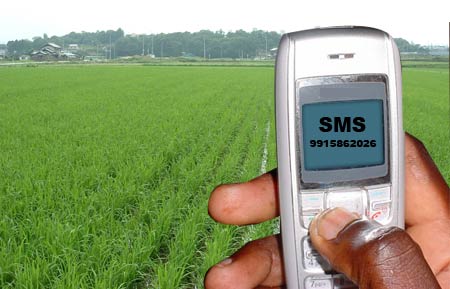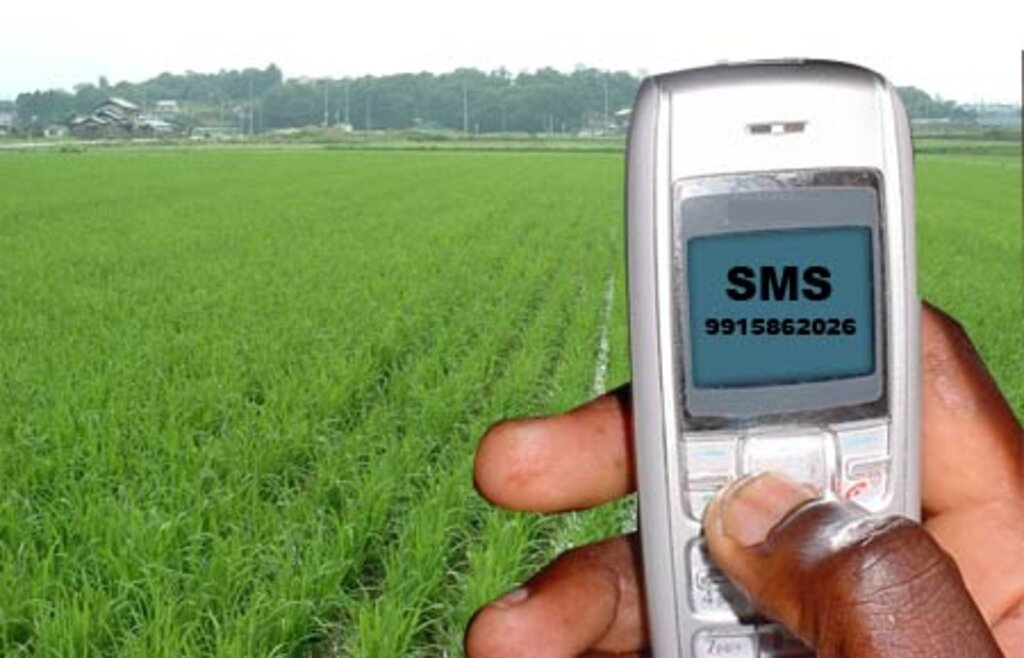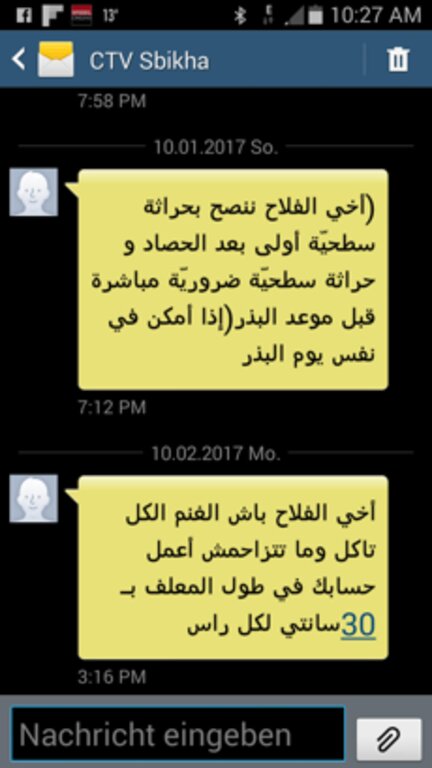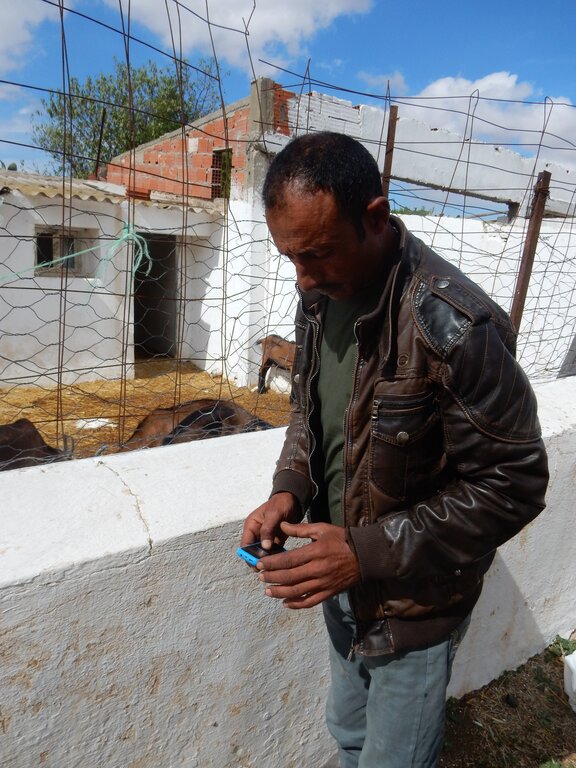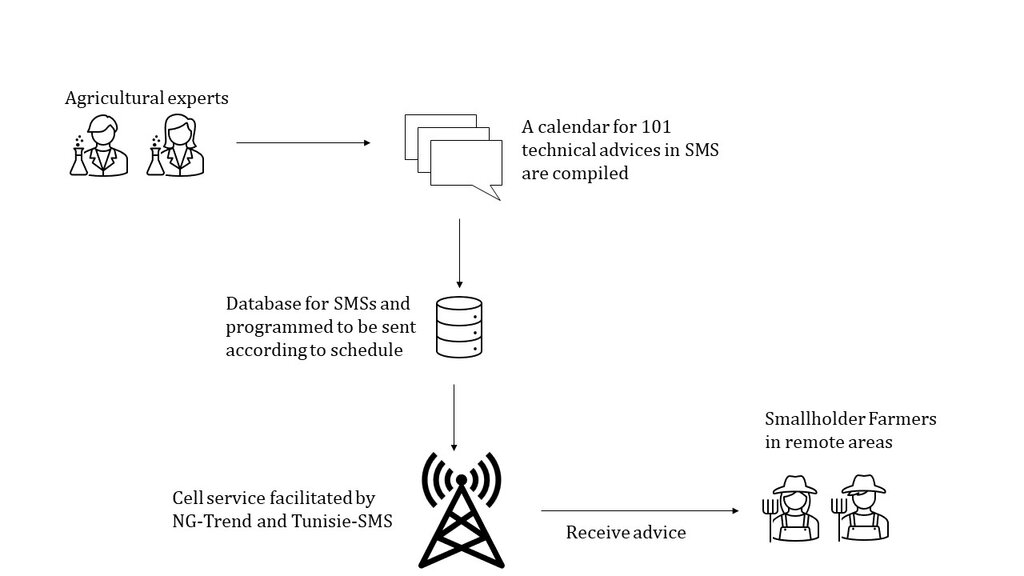ICT2Scale – supporting smallholder farmers with cellphone-based services via SMS [Tunisia]
- Creation:
- Update:
- Compiler: Joren Verbist
- Editor: –
- Reviewers: William Critchley, Rima Mekdaschi Studer, Joana Eichenberger
technologies_7002 - Tunisia
View sections
Expand all Collapse all1. General information
1.2 Contact details of resource persons and institutions involved in the assessment and documentation of the Technology
Key resource person(s)
Agricultural Innovation Specialist:
Rudiger Udo
International Center of Agriculture Research in the Dry Areas (ICARDA)
Tunisia
Agricultural Economist:
Frija Aymen
International Center of Agriculture Research in the Dry Areas (ICARDA)
Economics and Participatory Methods:
Idoudi Zied
International Center of Agriculture Research in the Dry Areas (ICARDA)
Agricultural and Resource Economist:
Dhebibi Boubaker
International Center of Agriculture Research in the Dry Areas (ICARDA)
PhD Candidate:
Oueghemmi H
International Center of Agriculture Research in the Dry Areas (ICARDA)
Name of project which facilitated the documentation/ evaluation of the Technology (if relevant)
ICARDA Institutional Knowledge Management InitiativeName of the institution(s) which facilitated the documentation/ evaluation of the Technology (if relevant)
International Center for Agricultural Research in the Dry Areas (ICARDA) - Lebanon1.3 Conditions regarding the use of data documented through WOCAT
The compiler and key resource person(s) accept the conditions regarding the use of data documented through WOCAT:
Yes
1.4 Declaration on sustainability of the described Technology
Is the Technology described here problematic with regard to land degradation, so that it cannot be declared a sustainable land management technology?
No
1.5 Reference to Questionnaire(s) on SLM Approaches (documented using WOCAT)
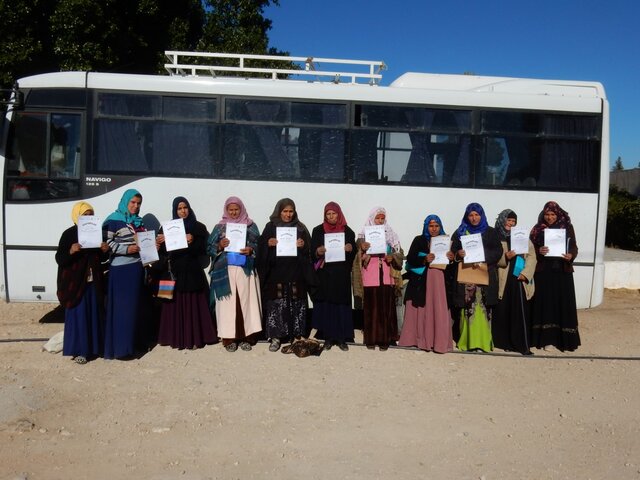
Lessons learned from the "Mind the Gap" project: … [Tunisia]
The “Mind the Gap” project researched the adoption gap between agricultural research and women and men farmers. Its objective was to determine most effective and cost-efficient technology transfer strategies and give recommendations to national extension institutes and development partners to adapt their scaling strategy
- Compiler: Joren Verbist
2. Description of the SLM Technology
2.1 Short description of the Technology
Definition of the Technology:
The ICT2Scale project contributes to better land management by supplying smallholder farmers with targeted SMS messages on diverse agricultural practices. This enables them to optimize resources and adopt more sustainable methods, consequently improving livelihoods in remote areas.
2.2 Detailed description of the Technology
Description:
In Tunisia, smallholder farmers rely heavily on extension services for information regarding new and sustainable agricultural practices, improved varieties, and market prices. Unfortunately, these services often fall short, particularly in remote areas, due to inadequate financial, human, and logistical resources. Information and Communication Technologies (ICT) can play a crucial role in filling this void. This can strongly contribute to developing the agricultural sector and reducing or preventing land degradation.
The ICT2Scale project aims to address these issues and reach these substantial group of farmers. The project was led by the International Center of Agricultural Research in Dry Areas (ICARDA). It was initiated in 2019 with a survey to identify the information needs of smallholder farmers. Tunisian farming experts crafted 101 technical SMS messages, disseminating them to approximately 1,000 smallholder farmers in Kairouan, Zaghouan, and Jendouba. These messages covered diverse commodities such as cereals, olives, citrus, honey, and livestock, simultaneously aiding farmers in sustainable land management and resource optimization.
A one-day workshop was organized to compile the advisory messages. Thirty specialists from various disciplines gathered, including different National Agricultural Research and Extension Services (NARES) centres. The workshop's estimated cost (including food and per diem) was around $1000 USD. Each SMS “unit” - of one message to one farmer - costs approximately $0.01 USD, totalling $1010 USD to make the 101 SMS available to 1000 farmers. Although the data services were provided free-of-charge by network companies, the overall project cost is still estimated at $3000 USD per year. Similar infrastructure with similar cost was implemented in the projects “Mind the Gap” and "Crop-Livestock and Conservation Agriculture (CLCA)".
A follow-up survey conducted by phone in May and June 2021 involved 421 SMS recipients, revealed that 60% found the messages useful, with 54% claiming to have learned something new. However, only 15% agreed that the messages arrived at the right time. Notably, 41% of farmers expressed a willingness to pay $0.01 USD per message after the project, indicating a potential avenue for the sustainability of this SMS technology. Farmers recommended using SMS for weather alerts and disease outbreaks; employing phone calls or Interactive Voice Responses (IVR); sending messages at the right time; and incorporating information on marketing, training, and livestock vaccination programmes.
Key advantages of an SMS service are:
-More cost-effective than in-person advice via public extension agents
-Particularly effective during the COVID-19 pandemic due to the lack of personal contact
-Immediate reach to thousands of farmers in case of emergencies or opportunities
-Flexible and adaptable for quick information updates
-Useful when extension resources, such as vehicles and funds, are limited or unavailable
-Effective in disseminating information about events like training and seed distribution
However, some weaknesses persist, including a lack of interaction (i.e. a top-down approach), less convincing than personal exchange, and ongoing funding challenges, with the Tunisian government hesitant to invest in the project without more dialogue and convincing arguments.
In summary, the ICT2Scale project has proved the viability and cost-effectiveness of employing SMS technology to reach smallholder farmers in remote areas. Consequently, this has the potential to enhance more sustainable and efficient use of land and natural resources, leading to an improvement in rural livelihoods. However, securing sustainable funding remains challenging in order to scale up and maximize impact.
Acknowledgement:
ICARDA’s work on Information and Communication Technologies (ICT) for agricultural development is supported by the German Agency for International Development (GIZ) in Collaboration with National Public Partners (AVFA, OEP, INRAT,ONAGRI, and CRDA) and Private Partners (NG Trend, Tunisie SMS) in Tunisia.
2.3 Photos of the Technology
2.5 Country/ region/ locations where the Technology has been applied and which are covered by this assessment
Country:
Tunisia
Region/ State/ Province:
Kairouan, Zaghouan, and Jendouba
Specify the spread of the Technology:
- applied at specific points/ concentrated on a small area
Is/are the technology site(s) located in a permanently protected area?
No
Map
×2.6 Date of implementation
Indicate year of implementation:
2019
2.7 Introduction of the Technology
Specify how the Technology was introduced:
- during experiments/ research
- through projects/ external interventions
3. Classification of the SLM Technology
3.1 Main purpose(s) of the Technology
- improve production
- reduce, prevent, restore land degradation
- reduce risk of disasters
- create beneficial economic impact
- create beneficial social impact
3.2 Current land use type(s) where the Technology is applied

Cropland
- Annual cropping
Annual cropping - Specify crops:
- cereals - barley

Grazing land
Extensive grazing:
- Semi-nomadic pastoralism
Animal type:
- goats
- sheep
Comments:
The SMS messages were directed to different land use and land management such as barley cultivation, livestock herding, and olive production.
3.3 Has land use changed due to the implementation of the Technology?
Has land use changed due to the implementation of the Technology?
- No (Continue with question 3.4)
3.4 Water supply
Water supply for the land on which the Technology is applied:
- rainfed
3.5 SLM group to which the Technology belongs
- agroforestry
- pastoralism and grazing land management
- integrated crop-livestock management
- Digital agriculture
3.6 SLM measures comprising the Technology

other measures
Specify:
Digital
Comments:
Most SMS messages were about agronomic and management measures.
3.7 Main types of land degradation addressed by the Technology

soil erosion by water
- Wt: loss of topsoil/ surface erosion

soil erosion by wind
- Et: loss of topsoil
- Ed: deflation and deposition

chemical soil deterioration
- Cn: fertility decline and reduced organic matter content (not caused by erosion)
- Cs: salinization/ alkalinization

biological degradation
- Bc: reduction of vegetation cover
- Bq: quantity/ biomass decline
3.8 Prevention, reduction, or restoration of land degradation
Specify the goal of the Technology with regard to land degradation:
- prevent land degradation
- reduce land degradation
Comments:
By informing farmers with technical advice, farmers can manage their land more sustainably.
4. Technical specifications, implementation activities, inputs, and costs
4.1 Technical drawing of the Technology
Technical specifications (related to technical drawing):
Agricultural experts from different National Agricultural Research and Extension Services (NARES), lead farmers and ICARDA scientists formulated 101 technical advises in SMS following an elaborated "agricultural" calendar. This way farmers receive technical advice when needed. This is facilitated by NG-Trend and Tunisie-SMS
Author:
Joren Verbist & Udo Rudiger
Date:
2024
4.2 General information regarding the calculation of inputs and costs
Specify how costs and inputs were calculated:
- per Technology unit
Specify unit:
Whole project / infrastructure
Specify currency used for cost calculations:
- USD
4.3 Establishment activities
| Activity | Timing (season) | |
|---|---|---|
| 1. | Workshop to compile technical advice | |
| 2. | Setting up network |
4.4 Costs and inputs needed for establishment
| Specify input | Unit | Quantity | Costs per Unit | Total costs per input | % of costs borne by land users | |
|---|---|---|---|---|---|---|
| Labour | Workshop to compile 101 SMS advice messages | workshop | 1.0 | 1000.0 | 1000.0 | |
| Equipment | SMS unit (101 SMSs to 1000 farmers) | unit | 101000.0 | 0.01 | 1010.0 | |
| Other | Remaining | 1.0 | 1000.0 | 1000.0 | ||
| Total costs for establishment of the Technology | 3010.0 | |||||
| Total costs for establishment of the Technology in USD | 3010.0 | |||||
4.7 Most important factors affecting the costs
Describe the most determinate factors affecting the costs:
...
5. Natural and human environment
5.1 Climate
Annual rainfall
- < 250 mm
- 251-500 mm
- 501-750 mm
- 751-1,000 mm
- 1,001-1,500 mm
- 1,501-2,000 mm
- 2,001-3,000 mm
- 3,001-4,000 mm
- > 4,000 mm
Agro-climatic zone
- semi-arid
- arid
5.2 Topography
Slopes on average:
- flat (0-2%)
- gentle (3-5%)
- moderate (6-10%)
- rolling (11-15%)
- hilly (16-30%)
- steep (31-60%)
- very steep (>60%)
Landforms:
- plateau/plains
- ridges
- mountain slopes
- hill slopes
- footslopes
- valley floors
Altitudinal zone:
- 0-100 m a.s.l.
- 101-500 m a.s.l.
- 501-1,000 m a.s.l.
- 1,001-1,500 m a.s.l.
- 1,501-2,000 m a.s.l.
- 2,001-2,500 m a.s.l.
- 2,501-3,000 m a.s.l.
- 3,001-4,000 m a.s.l.
- > 4,000 m a.s.l.
Indicate if the Technology is specifically applied in:
- not relevant
5.3 Soils
Soil depth on average:
- very shallow (0-20 cm)
- shallow (21-50 cm)
- moderately deep (51-80 cm)
- deep (81-120 cm)
- very deep (> 120 cm)
Soil texture (topsoil):
- coarse/ light (sandy)
- medium (loamy, silty)
Soil texture (> 20 cm below surface):
- coarse/ light (sandy)
- medium (loamy, silty)
Topsoil organic matter:
- low (<1%)
5.4 Water availability and quality
Ground water table:
5-50 m
Availability of surface water:
poor/ none
Water quality (untreated):
for agricultural use only (irrigation)
Water quality refers to:
ground water
Is water salinity a problem?
Yes
Is flooding of the area occurring?
No
5.5 Biodiversity
Species diversity:
- low
Habitat diversity:
- low
5.6 Characteristics of land users applying the Technology
Sedentary or nomadic:
- Sedentary
Market orientation of production system:
- mixed (subsistence/ commercial)
Off-farm income:
- 10-50% of all income
Relative level of wealth:
- poor
- average
Individuals or groups:
- individual/ household
- groups/ community
Level of mechanization:
- manual work
- mechanized/ motorized
Gender:
- women
- men
Age of land users:
- middle-aged
- elderly
5.7 Average area of land used by land users applying the Technology
- < 0.5 ha
- 0.5-1 ha
- 1-2 ha
- 2-5 ha
- 5-15 ha
- 15-50 ha
- 50-100 ha
- 100-500 ha
- 500-1,000 ha
- 1,000-10,000 ha
- > 10,000 ha
Is this considered small-, medium- or large-scale (referring to local context)?
- small-scale
5.8 Land ownership, land use rights, and water use rights
Land ownership:
- individual, not titled
- individual, titled
Land use rights:
- individual
Water use rights:
- communal (organized)
- individual
Are land use rights based on a traditional legal system?
Yes
5.9 Access to services and infrastructure
health:
- poor
- moderate
- good
education:
- poor
- moderate
- good
technical assistance:
- poor
- moderate
- good
employment (e.g. off-farm):
- poor
- moderate
- good
markets:
- poor
- moderate
- good
energy:
- poor
- moderate
- good
roads and transport:
- poor
- moderate
- good
drinking water and sanitation:
- poor
- moderate
- good
6. Impacts and concluding statements
6.1 On-site impacts the Technology has shown
Socio-economic impacts
Production
crop production
Comments/ specify:
By informing farmers with technical advise, it is expected that the production increases.
crop quality
Comments/ specify:
By informing farmers with technical advise, it is expected that the quality of production increases.
animal production
Comments/ specify:
By informing farmers with technical advise, it is expected that the production increases.
Income and costs
expenses on agricultural inputs
Comments/ specify:
By informing farmers with technical advise and current prices, so they can lower their expenses.
farm income
Comments/ specify:
By informing farmers with technical advise and current prices, it is expected they can increase their selling prices.
Ecological impacts
Soil
soil loss
Comments/ specify:
By informing farmers when the best moment is to plough the field, soil loss through erosion is reduced.
Climate and disaster risk reduction
drought impacts
Comments/ specify:
Informing farmers about management operations and their timing, drought impact decrease
6.3 Exposure and sensitivity of the Technology to gradual climate change and climate-related extremes/ disasters (as perceived by land users)
Gradual climate change
Gradual climate change
| Season | increase or decrease | How does the Technology cope with it? | |
|---|---|---|---|
| annual temperature | increase | very well |
Comments:
Farmers can receive various advice that allows them to cope with a wide range of climate-change induced issues and disasters.
6.4 Cost-benefit analysis
How do the benefits compare with the establishment costs (from land users’ perspective)?
Short-term returns:
very positive
Long-term returns:
very positive
How do the benefits compare with the maintenance/ recurrent costs (from land users' perspective)?
Short-term returns:
very positive
Long-term returns:
very positive
6.5 Adoption of the Technology
- single cases/ experimental
If available, quantify (no. of households and/ or area covered):
Around 1000 smallholder farmers
Of all those who have adopted the Technology, how many did so spontaneously, i.e. without receiving any material incentives/ payments?
- 11-50%
6.6 Adaptation
Has the Technology been modified recently to adapt to changing conditions?
No
6.7 Strengths/ advantages/ opportunities of the Technology
| Strengths/ advantages/ opportunities in the land user’s view |
|---|
| The system in SMS-based which does require a smartphone, making it more accessible. |
| The technical advises allow to improve production practices. |
| The technical advice gives good reference for current practices |
| Strengths/ advantages/ opportunities in the compiler’s or other key resource person’s view |
|---|
| More cost-effective than in-person advice via public extension agents |
| Particularly effective during the COVID-19 pandemic due to the lack of personal contact |
| Immediate reach to thousands of farmers in case of emergencies or opportunities |
| Flexible and adaptable for quick information updates |
| Useful when extension resources, such as vehicles and funds, are limited or unavailable |
| Effective in disseminating information about upcoming events like training and seed distribution |
6.8 Weaknesses/ disadvantages/ risks of the Technology and ways of overcoming them
| Weaknesses/ disadvantages/ risks in the land user’s view | How can they be overcome? |
|---|---|
| SMS is often received at wrong timing. | |
| SMS messages did not include advice on animal vaccination programs. | Include this in the technical advice |
| SMS messages did not include early warnings for (weather) hazards. | Include this as well in the infrastructure and adding underpinning (weather) forecast models for this. |
| Weaknesses/ disadvantages/ risks in the compiler’s or other key resource person’s view | How can they be overcome? |
|---|---|
| SMS is not useful for illiterate farmers | Education in the rural areas should be improved in general. |
| Lack of dialogue (a top-down approach) | Include farmers when writing the advice and consider their needs beforehand, which was also done during the project. |
| Less convincing than personal exchanges | |
| Challenging to have ongoing investment | By showing to donors and national government that using SMS services is a viable and cost-effective way to improve rural livelihoods and make better use of the land and natural resources. |
7. References and links
7.1 Methods/ sources of information
- interviews with land users
- interviews with SLM specialists/ experts
- compilation from reports and other existing documentation
7.3 Links to relevant online information
Title/ description:
Boubaker Dhehibi, Mohamed Zied Dhraief, Udo Rudiger. (20/9/2021). Lesson learned from the study on "Impact of Information and Communication Technologies (ICTs) on Agricultural Development in Tunisia". Beirut, Lebanon: International Center for Agricultural Research in the Dry Areas (ICARDA).
URL:
https://hdl.handle.net/20.500.11766/66236
Title/ description:
Boubaker Dhehibi, Mohamed Zied Dhraief, Aymen Frija, Hassen Ouerghemmi, Barbara Rischkowsky, Udo Rudiger. (26/10/2023). A contextual ICT model to explain adoption of mobile applications in developing countries: A case study of Tunisia. PLoS ONE, 18 (10).
URL:
https://hdl.handle.net/20.500.11766/68779
Title/ description:
List of SMS messages to be send to farmers.
URL:
https://hdl.handle.net/20.500.11766/10637
Title/ description:
Udo Rudiger, Boubaker Dhehibi. (5/11/2021). General project "ICT2Scale" presentation.
URL:
https://hdl.handle.net/20.500.11766/66426
Links and modules
Expand all Collapse allLinks

Lessons learned from the "Mind the Gap" project: … [Tunisia]
The “Mind the Gap” project researched the adoption gap between agricultural research and women and men farmers. Its objective was to determine most effective and cost-efficient technology transfer strategies and give recommendations to national extension institutes and development partners to adapt their scaling strategy
- Compiler: Joren Verbist
Modules
No modules


